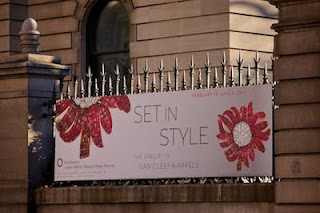 |
Believe it or not, this is a Van Cleef & Arpels brooch.
Would you wear it? |
Welcome to
Nature, Part III of
Set in Style, the Van Cleef & Arpels exhibit at the Cooper-Hewitt, National Design Museum. Many of the pieces in this category were brooches and, no offense, brooches (or pins) are probably the most boring piece of jewelry one can own. Even the word
brooch sounds old, like it should come in a mothball can.
 |
I think brooches are boring.
Unless we're talking about one of VC&A's Set in Style treasures,
then that's a different story. |
Every now and then, a client will come to my counter (usually an older person) to ask if we have any brooches. When we say we don’t have any in stock, this person often looks at us like we are dumb as rocks for missing the biggest selling opportunity to ever come along. Sometimes, this person will continue to give me an attitude, at which I say things like, “gee, I haven’t even seen a brooch in the past 30 years.” (Like, hello, go back to your coffin - it's almost daylight).
Therefore, if you are a younger person, most likely you don’t own a brooch since they haven’t been in style for a really long time. You might have one or two lying in the bottom of your jewelry box like I do, but you don’t wear them because you have so many other cool things that you wear all the time, however, there are those women who still wear them (corporate world, attorneys, etc) because of the way they can finish their look.
I think pins look best on suits, but women just don’t wear that many suits anymore. Today, women tend to show a Iot more skin, and it’s hard to pin a pin on skin. I really haven't seen pins since the Alexis Carrington
Dynasty days of the 80's when suits were structured and had runway sized shoulder pads. Pins actually soften the look of a suit, and that’s why women like Hillary Clinton and Madeleine Albright look good in pins because they can be somewhat cardboard in appearance when conducting business. However, take a look at Hillary Clinton at her daughter Chelsea's wedding last year. I thought she looked her best in her silky, turquoise caftan (rather than as we usually see her).
 |
| Looking more like wood. |
 |
| Flowing and looking less like wood. |
Someone who really knows how to wear a pin is Madeleine Albright. She used pins to set a tone for important meetings during her tenure as Ambassador to the United Nations and as Secretary of State. She, as many women do, used jewelry to commemorate an event or indicate how she felt. She did this through pins, and she did it well. She wore an antique snake pin when she met with Saddam Hussein, and a “hear no evil, see no evil, speak no evil” monkey pin when she met with Vladimir Putin to indicate her position on the Chechen atrocities. Putin told President Clinton he could tell how a meeting with Albright might go depending on her pin.
This was an imaginative and creative use of jewelry, and her book,
Read My Pins, tells us the thought process behind the pins she chose to wear depending upon whom she was meeting. Think about a woman as busy as Albright. Not only did she have to do her hair and get dressed in the morning, she also had to pick out the right pin. I will never complain again about getting ready for work in the morning because one thing I don't have to do is coordinate my jewelry with history.
 |
You go girl....I think she's pissed because she wasn't allowed
to go down in that hole and pull Saddam out! |
|
But I digress. The brooches inspired by nature in the VC&A exhibit are magnificent. The platinum and diamond “Orchid” brooch (1928), the gold and diamond “Snowflake” brooch (1948), the diamond and pearl “Bunch of Grapes” brooch (1915), the diamond and emerald (or sapphire or ruby) “Sycamore Leaf” brooch (1951), and my personal favorite, the enormous and completely ridiculous “Scarlet Macaw” brooch (1995). Made from diamonds, rubies and sapphires, the beak is made from coral and onyx. This brooch, as other VC&A brooches, is really big. Of course, that means more precious stones, which equals more expensive, but that’s what VC&A’s is all about. I just get a fit of hysterics when I think of someone wearing this pin on her shoulder. ARG!
 |
| My orchids always die. I would take better care of this one. |
 |
| What a shame you can you only wear this in winter. |
| | |
 |
| The Grapes of Want. |
 |
| I would have no problem raking these leaves if they fell in my yard. |
 |
| Must be worn on the shoulder while on a wooden ship. |




























